“The object of love is the best and most beautiful. Try to live up to it.” John Steinbeck to his newly in-love son
“I now pronounce you man and wife, you may now change your Facebook status.” Random internet person
“So, I heard you married your sister?” Multiple Jewish mothers to me following the wedding
“Well, no, I just officiated the wedding...”
ALL OF The GUESTS were making their way to the beach as I stood, like Peter Pan, gesturing to my reflection in one of the windowed-walls of the Singer Island Marriott in West Palm Beach, Florida. People were yelling my name as they walked by, probably wondering what the hell I was doing. I must have looked ridiculous but I barely heard them. I had bigger worries: my sister’s wedding was mere minutes away and I wasn’t fully confident in what I was about to do.
Nearly seven months back, my sister, Marni (or Marnzee Parnzee as shes known around these parts), and her husband, Shawn, asked me to officiate their wedding. And, although I had never even seen a wedding officiated by a non-Rabbi or non-priest (pastor? Father?), much less officiated before, my first reactions was, of course! I accepted with that unfounded confidence with which I seem to commit to far-off endeavors.
For a guy like me, this reaction is probably expected. I mean, I have always been a fan of trying unfamiliar things, like a volunteer trip in Spain, or a meditation retreat, or Seth Godin’s AltMBA. Even better if the scary thing involves speaking in front of a group of people (I like attention). Plus, being asked stoked my ego (historically, a good bet to get me to do anything, given my life-long allegiance to it).
But this one had a different feeling to it. It wasn’t the normal pride or selfish excitement that drove my enthusiastic acceptance. It felt nobler, more automatic, and more selfless than a mere challenge or adventure. It activated that feeling deep in my body that I have referred to before – the one that Professor Jon Haidt calls “elevation.”
We’ve all felt this feeling – the one that “dilates your breast and elevates your sentiments,” as Jefferson put it (he said with arrogance). The source of the feeling here was not about me, but rather refreshingly, about my sister. Throughout my life, she’s been my second mom: picking out cool clothes for me, teaching me about girls, making me endless skillets of egg-based concoctions or smoothies or bananas foster, and doing basically anything and everything for me, whether or not I had asked.
After those 30 years of dedication from a person – you don’t consider a response to a request – you simply do it. As Billy Madison said, you get your ass out there and you find that fuckin’ dog!
For me, the request was a mere formality – as there is no request, especially regarding something as important as her wedding, that I would have denied. And, thankfully, it was a reminder of the love I have for my sister – the love that I far too often forget to appreciate.
I HELD ONTO these feelings for the rest of the conversation, forming over my head an imaginary bubble filled with the simulation of this glorious scene: my fam, friends in  attendance, I just, of course, crushed it, we’re all cry-laughing, and we dance the night away, my sister happy as ever. I stayed with this fantasy for some time, but then, the bubble popped immediately as I was smacked in the face by an enormous realization…
attendance, I just, of course, crushed it, we’re all cry-laughing, and we dance the night away, my sister happy as ever. I stayed with this fantasy for some time, but then, the bubble popped immediately as I was smacked in the face by an enormous realization…
“I love Josh.”
Just kidding. That’s a line from Clueless.
What I realized was – I knew nothing. Nothing about weddings, or officiating them, or 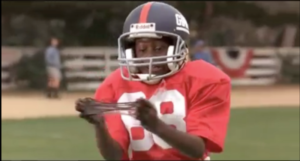 how much work it would take… I felt like how Little Giant’s star receiver,“Hot Hands” Hanon – felt after the stick’em stuck to his jersey. Oh crud.
how much work it would take… I felt like how Little Giant’s star receiver,“Hot Hands” Hanon – felt after the stick’em stuck to his jersey. Oh crud.
I worried about this for most of the rest of the afternoon. Then, in an attempt to shake it off, I took a long walk, started breathing again, and sat down with a piece of paper and a decaf americano (Americano = snob; decaf = pansy). Then, for about an hour, I wrote out what I knew (very little) and what were the best possible ways to find out.
Eventually, I did break through this initial fog, created a plan, and ended up doing a decent job. In fact, afterwards, many people were coming up to me and saying that it seemed like it was so “easy and natural” for me. But, as Michelangelo said: if they knew how hard I worked to get my mastery, it wouldn’t seem so wonderful at all.
 Except, in my case, it about 6 months of work, not decades. And, of course, what I delivered was far from a product of “mastery.” I made tons of mistakes, not the least of which was forgetting to introduce and thank my cuz, Scotters, who was strumming away on the guitar like Orpheus strumming the lyre. Sorry Scottster.
Except, in my case, it about 6 months of work, not decades. And, of course, what I delivered was far from a product of “mastery.” I made tons of mistakes, not the least of which was forgetting to introduce and thank my cuz, Scotters, who was strumming away on the guitar like Orpheus strumming the lyre. Sorry Scottster. 
So, in order to dispel anyone from the notion of me being a “natural,” and in order to prevent anyone else from feeling this sort of doubt in the future (and to advertise for my very fairly priced officiant services at $15,000 a pop), I am going to write out the steps (and missteps) I took in officiating the wedding. I’ll tell you about how to start (generally the hardest part), how to actually become an officiant, how I expedited my learning, how to memorize a speech, and what not to do (including not forgetting one MAJOR thing that I happened to).
So, ok cats, through your mittens around your kittens and AWAY WE GO…
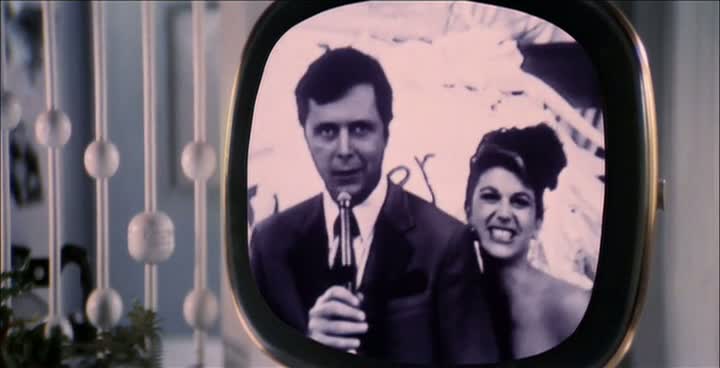
Seven Steps Of Highly Effective Officiants
- Decide What
- Find a Teacher
- Set a Plan
- Research
- Shitty First Draft
- Logistics and Collaboration
- Refine and Memorize
Step 1: Decide on the “WHAT”
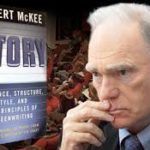 I recently attended a popular seminar in Los Angeles called The STORY Seminar. The seminar is taught by Robert McKee, a long-time actor, writer, director from Broadway to Hollywood. One of the central points in creating a great story, Mckee says, is to determine the “object of desire.” That is, what does the protagonist of your story want? What is he after? What are you after in writing this?
I recently attended a popular seminar in Los Angeles called The STORY Seminar. The seminar is taught by Robert McKee, a long-time actor, writer, director from Broadway to Hollywood. One of the central points in creating a great story, Mckee says, is to determine the “object of desire.” That is, what does the protagonist of your story want? What is he after? What are you after in writing this?
“An unclear object of desire makes for unclear writing.” Robert McKee
McKee is not alone, John Grisham knows the last scene of his books before he even starts writing them; so does Malcolm Gladwell. Author, Speaker, Marketer, Seth Godin stresses starting every project by answering the question: “What’s it for?” Liz Gilbert – of Eat, Pray, Love fame- writes the following in her book Big Magic on how to be creative in the face of self-doubt: “Defending yourself as a creative person begins by defining yourself; it begins when you declare your intent.”
This advice is in no way limited to the sphere of writing. In fact, in just about every industry, skill, or practice I have read about, spanning the arts, sciences, business, health, and politics, this idea of starting with WHAT – the object of desire, the goal, etc. – is step one.
From Bridwater’s Dalio (“have clear goals“), to Denzel (“dreams are nothing without goals“), to social psychologist Mihaly Csikszentmihalyi (“goals transform a random walk into a chase“), everyone is in agreement. As the colorful speaker Zig Ziglar said,
“if you aim at nothing, you’ll hit it every time.”
Crucially, what is not step one is “HOW” you will get there. This is the main hag up we often face when trying to do something we haven’t done before, says Napoleon Hill, a journalist who interviewed many of the most successful 20th century businessmen. We think, “well how am I supposed to know how to do that? I’ve never done it before.” Many times we do this before deciding and clearly writing out exactly WHAT it is that we want to accomplish. As Hill tells us, this causes pervasive stalling.
Ok, we get it, Justin, the WHAT is important. Great.
For me, the big outcome was straightforward – a ceremony representative of the love, playfulness, care, comfortability, casualness, and family that was characteristic of the lives and relationship of the bride and groom.
I then broke these into smaller outcomes:
- Actually have the authority – become an officiant
- Build a playful and light speech that is entertaining without being me-focused and filled with the love and ideas from their own actions and feelings.
- Note: to build something “playful and light” turns out to be an interesting paradox because, like any good comedian will tell you, the more you try to be playful or funny, the more it sounds contrived. You merely need to write “as yourself.” If you are truly playful and light, that’s what will come out.
- A good understanding of the fundamental structure of normal weddings – and where I can depart
- Something that is in line with Shawn and Marni’s goals
Ok so how do I figure all of this out? Remember, I am coming from very little knowledge. The best first step advised by most I’ve seen when learning a new skill or trade: find a teacher…
Step 2: Find a Teacher or Model
“Only a fool learns from his own mistakes, the wise man learns from the mistakes of others.” Prussian Leader Otto Von Bismarck
At first, my second step was to write out a bunch of lists of how to get to those outcomes. But, after getting tangled up, I luckily remembered the advice of nearly everyone in the areas of business, science, athletics, or art: find a teacher. Find influences, examples, and copy them. Someone has done this before – likely, a lot of someones.
“The mentor-protégé relationship is the most efficient and productive form of learning. Robert Greene, Mastery”
Big Willie Smith credits much of his success to teachers. He points out, whatever problem you have, there is someone who has done it before and then written about it, or, if you’re lucky, will speak to you about it. (Hey, it worked for Albert Brennaman…).
Finding a model, which, again, can be as simple as a guidebook or video (or perhaps this blog post), will save you a lot of the anguish and some of the missteps that they took in their processes. It will also spark your imagination and point out things you hadn’t considered.
I was extremely lucky in this respect as a family friend of mine pointed out, early on, that her cousin had officiated multiple weddings. I immediately set up a call with him.
His name is Jon, and, from my perspective, Jon was my master mentor. He had experience, he had similar goals in his speeches (funny but also loving) and (very important) he was willing to help me in many ways.
I have my notes from our first conversation. He took me through the process piecemeal and as if I had no clue what I was doing – which was rather handy given that I did not. He helped me in at least four ways:
- How to literally become an officiant – a process I imagined would take weeks that actually takes minutes. (Sorta makes you rethink the holiness of the position, eh?).
- His Process Applied, Step-By-Step. It was useful to hear not just theory and structure, but the two applied to an actual example.
- Tone, length, humor, the structure and format – all of the attitude and organization. Again, he went through examples to help me understand.
- Build My Confidence. He did this by assuring me that he also had no idea what he was doing at first but he was able to do it – and so could I. He also insisted that I send him over what I had when I had a working draft, and he would gladly give me notes.
This was exceedingly helpful for two reasons: (1) it forced me to get together an intelligible working draft and (2) it prevented at least some tendency to be “perfect” and instead just produce what the writer Anne Lamott advises we start with: a shitty first-draft.
With all of these notes, I now had a process created for me:
- get the license,
- do research (i.e. Watch videos and take notes, interview bride and groom, revisit or research people who have written about love and marriage, get quotes and meaningful passages),
- write out my thoughts about the two of them and their relationship
- Don’t worry, just write
Now to create a plan…
Step 3: Brainstorm a List of Actions, then Prioritize it by Importance and Time
“If you have built castles in the air, your work need not be lost; that is where they should be. Now, put the foundation under them.” Henry David Thoreau
famousbloggers.com
OK, so now I have my outcomes from Step 1, I have my model from Step 2, now I need to create a plan of action i.e. build the foundation. Specifically, I need to look at my model, decide which things are most important and which things are dependent on other actions, and then physically schedule out a time to do it all.
To help me, I used a couple examples I had read about:
- BATCHING. Adam Grant in Give and Take tells us giving to others is less likely to lead to burnout if we “bundle” it, or – to take a Tim Ferriss phrase – “batch” it. So, it may be better to give to others for seven hours one day per week than to give an hour each day. Since reading that, I have made Sundays the days I give to others, and so I plotted out my schedule for the remaining Sundays until Judgement Day – April 1.
- PROCRASTINATION. Another tip of Grant’s that helped me here was one on the topics of creativity and procrastination. Many of us think of procrastination as a bad thing, and much of the time, it probably is (great article by Tim Urban on this). Procrastination is bad if we wait until the last minute without starting anything.
However, if we start a project very early – starting writing it and thinking about it long before the due date, our subconscious has time to work. This type of thinking is what researchers call the “diffuse mode” of thinking. Essentially, as soon as we start something and do not finish it, our mind goes to work on it, forming random connections, even when we are not directly focusing on it.
I had about 20 Sundays when I got around to plotting out my schedule. I had a feeling, based on advice from thinkers like Ferriss and Cal Newport, that I would probably over-estimate what I could do in any one session – so timed each activity liberally. I also prioritized the activities by how long I thought each one would take and what would be the hardest to do. Like the Twain saying advises: eat your frogs first.
For me, the hardest thing, the most important thing, and the thing that would require the most time to marinate, were the same activity: writing the speech. The other activities like becoming an officiant, ordering the procession, even the structure, wouldn’t take nearly as much time.
But, a prerequisite to writing the speech for me was gather the material about which to write – i.e. the research. So for the first three Sundays I researched the topic.
After the research, the path was something like this:
- Sundays 4 – 8: Write the shitty first draft and send that draft to __,
- Sundays 9-11: Take a break and do the logistics. e. planning the procession, becoming an officiant, involving other people, meeting with Bride and Groom in person,
- Sundays 12 – 14: Rewrite first draft so it’s not so shitty
- Sundays 15 – 17: Finalize other peoples roles, gathering quotes and passages, and other lose ends,
- Sundays 18-20: finalize edits and memorize
Here’s an early form of my checklist:
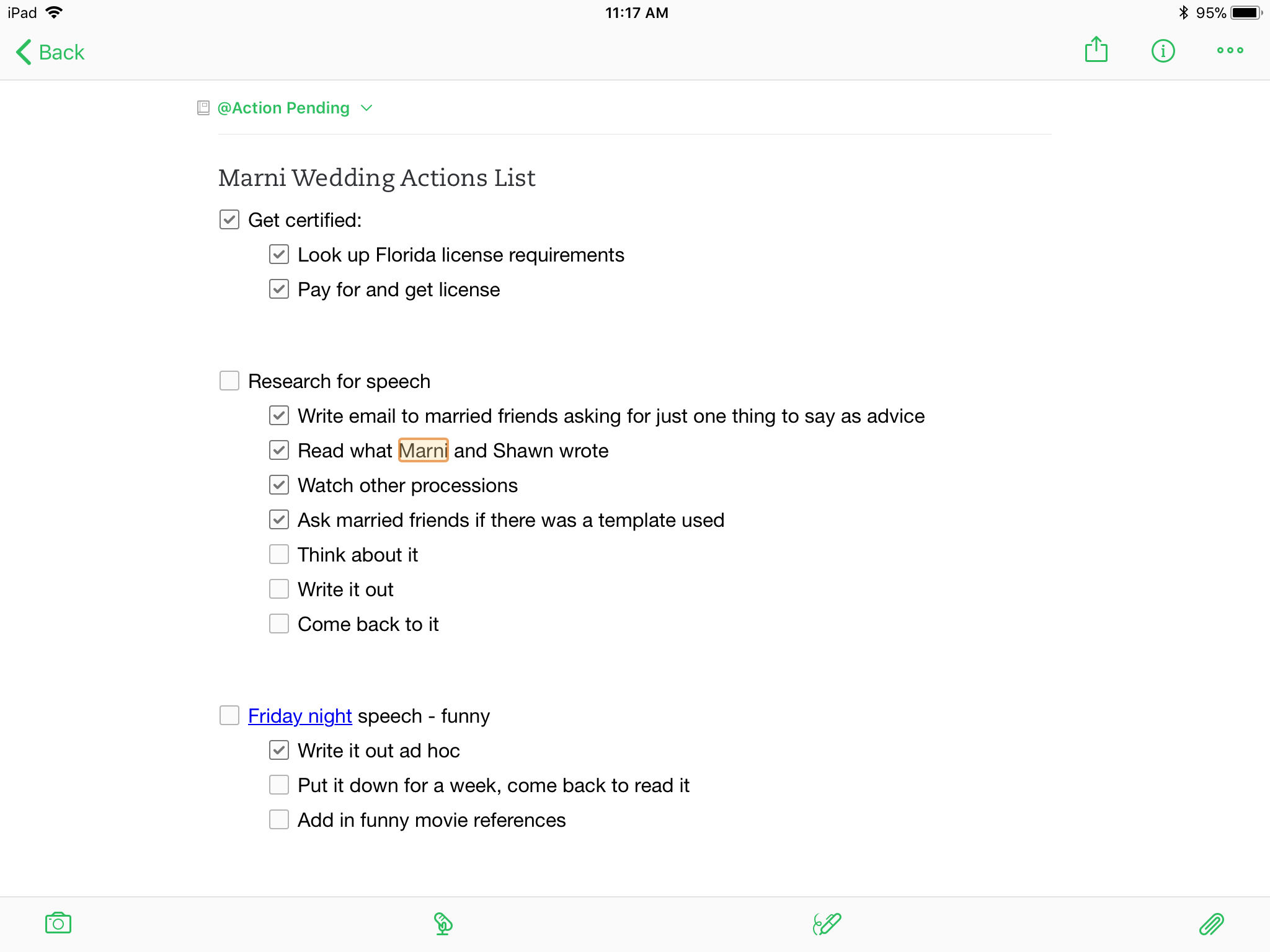
Of course, many Sundays I did not get things done as I had hoped, and other people being involved made things bleed into other days of the week. Some Sundays I missed do to other commitments, trips, hangovers, whatever. But since I started so far in advance, those things were planned collateral damage.
Let’s move onto the research piece…
Step 4: Gathering Sand Piles – The Research.
Collect Interviews, love texts and quotes, asking others for help, watching videos of other weddings, etc.

imovingtolondon.com
In January, I attended a writing workshop in Newport, Rhode Island held by the two best selling authors of Thanks for The Feedback. There, they talked about how making something was like building sand castles. Before you start constructing the castles, you first need to gather the sand into one place. I like this as a metaphor for any project.
As I was instructed by my officiant mentor, Jon, the first bits of sand that I was to gather were the interviews of both bride and the groom. It would be a mistake, Jon assured me, to just imagine what I viewed as being a good way to shape this event before understanding what my sister and Shawn actually wanted. I guess it is there wedding after all…
Research Step #1 – Interviewing the Bride and Groom
The first thing I wanted to do was to meet them and conduct separate, in-person interviews. I wanted to do this as early as possible in the process so I had a lot of time to think about how to play in this “world” they were going to outline. Luckily, in a few weeks I’d be on my home ready to purge my sins over the high holiday of Yom Kippur.
Prior to arriving, and to prepare them for what I would ask, I sent them a few general  questions about everything from the logistics of the ceremony they envisioned, all the way to concepts of love and marriage (basically all from Al Bundy). My goal was to get them to rift on the concepts and ideas of what this was about – and then I would try and help by pulling out the patterns and ideas in order to form the wedding.
questions about everything from the logistics of the ceremony they envisioned, all the way to concepts of love and marriage (basically all from Al Bundy). My goal was to get them to rift on the concepts and ideas of what this was about – and then I would try and help by pulling out the patterns and ideas in order to form the wedding.
Ironically, without realizing it at the time, I set up the in-person interview with Shawn (the hubby) at my sister’s ex-boyfriend’s family’s restaurant… yikes. I would advise against this.
Below is what I sent to them in an email dated October 1, 2016 – exactly 6 months pre-wedding:
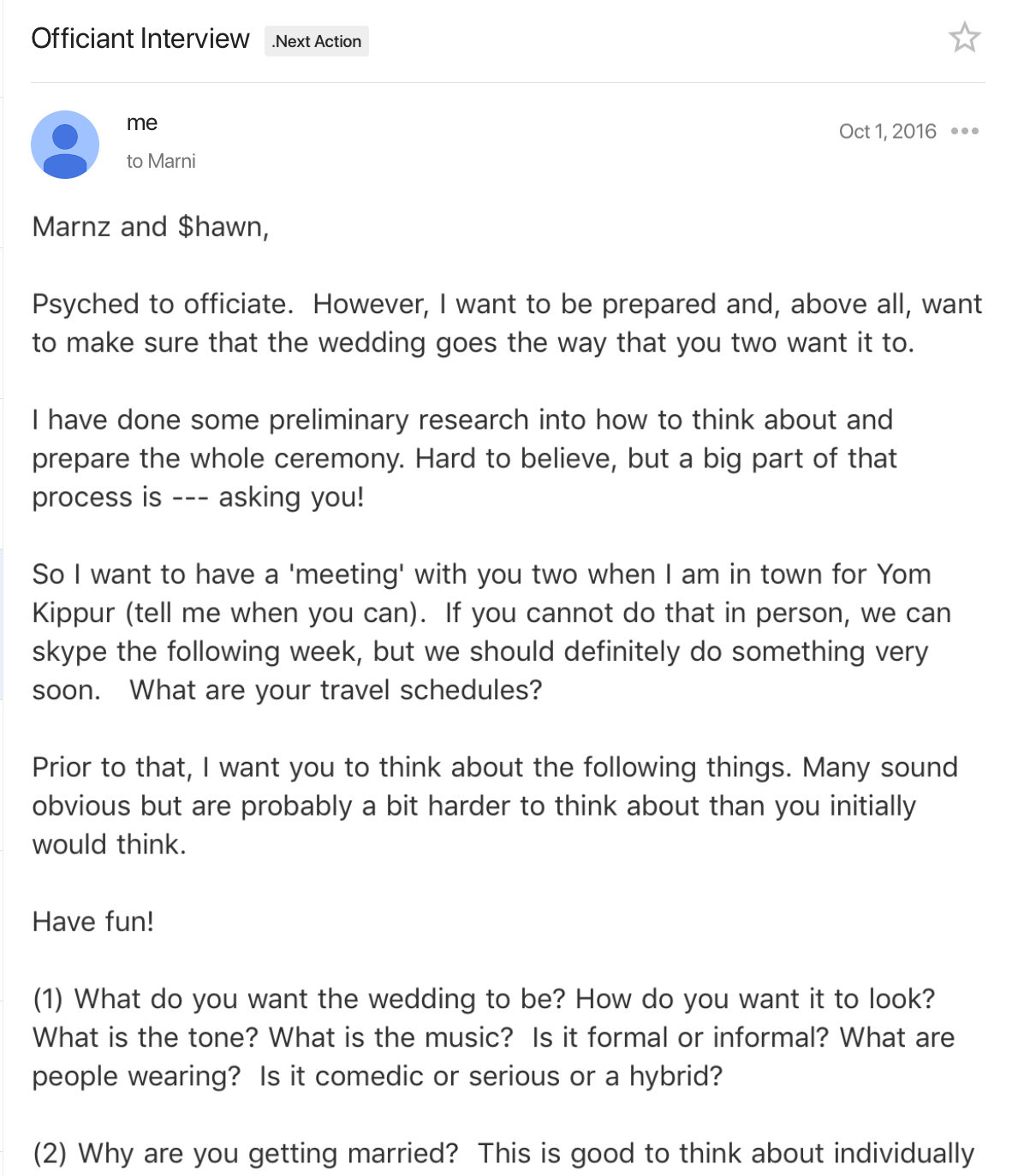
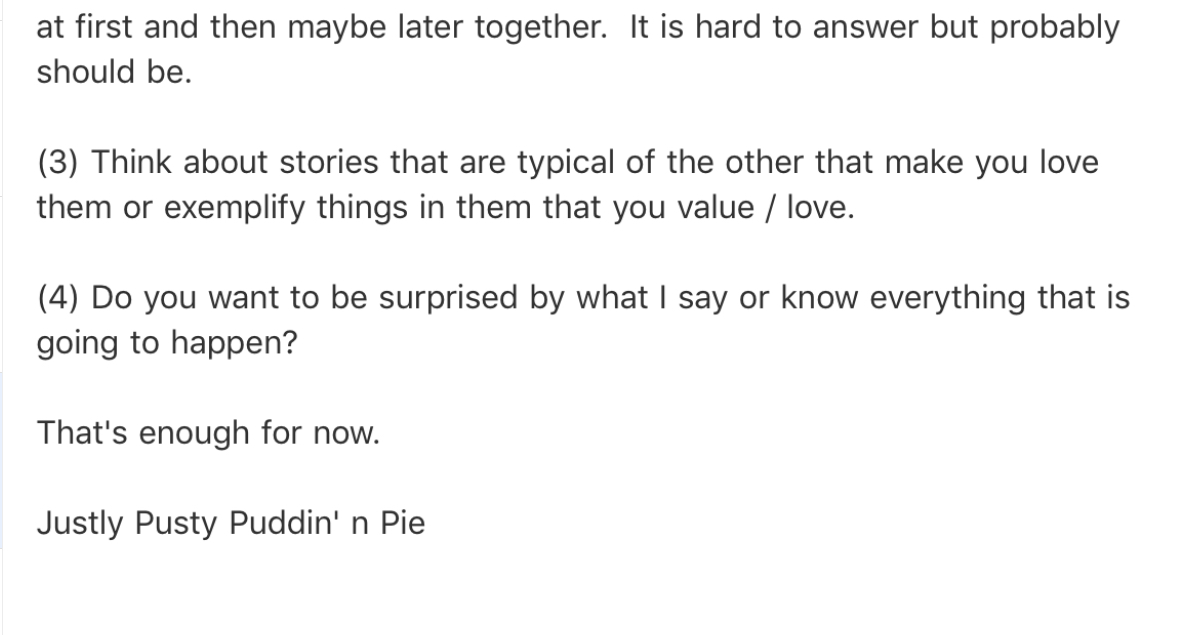
As I note, I wanted them to consider these things completely separately and hopefully not speak about them. Research on team dynamic suggests that this is a better way to get each person’s point of view. Later I can blend them together.
In addition to the in person interview – I also sent some email questions and then held a couple phone interviews each. As you can see, I continued pestering them all the way up until just a couple weeks from the wedding. I wanted to make sure that the content of this wedding was truly authored by them. Parallel to all this, of course, I was conducting separate research…
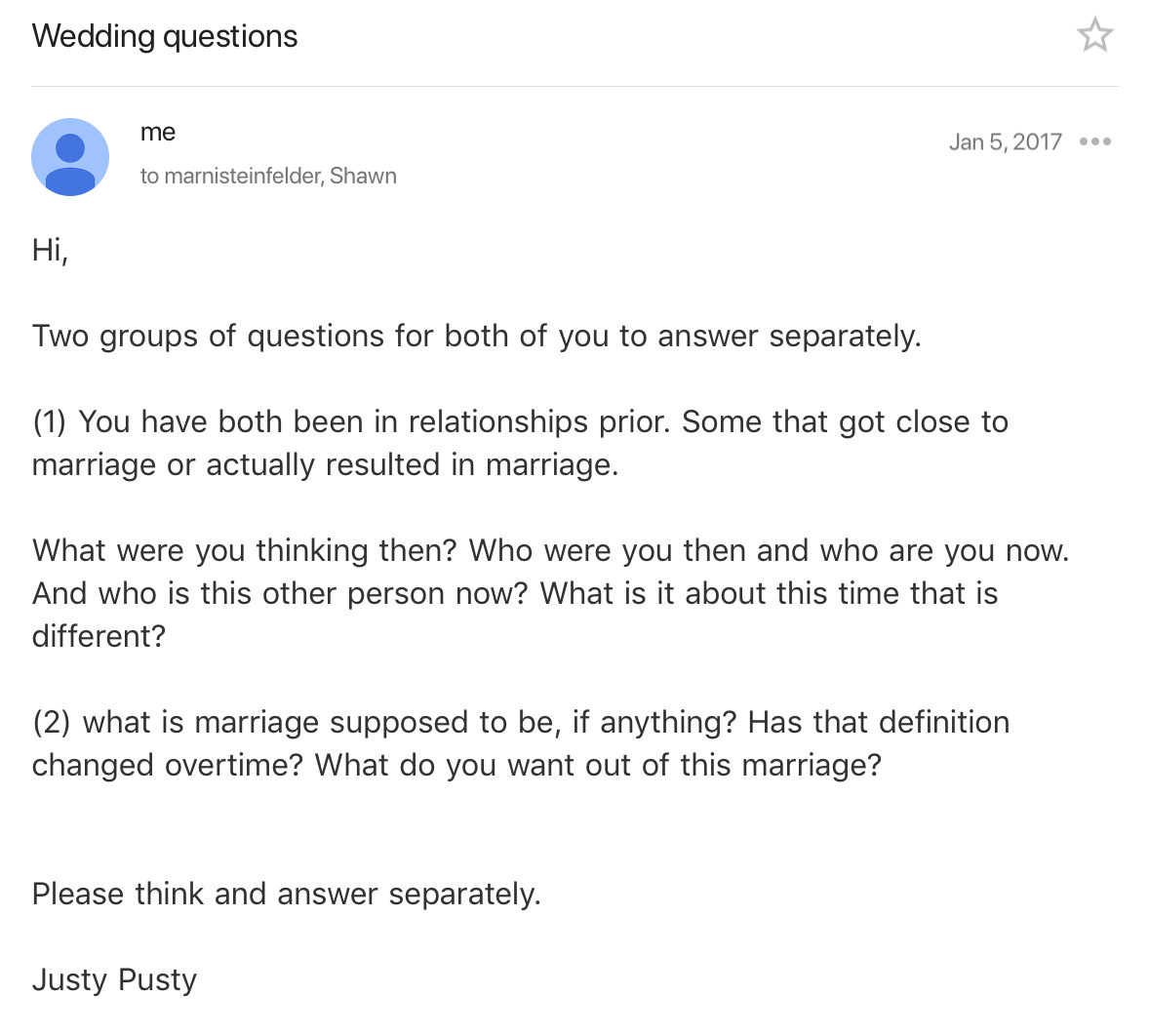
Other Research
- Videos. Tons of YouTube videos of both traditional and non-traditional weddings to see what the fundamental form was, and then how officiants tended to play with the boundaries a bit. As I did this, I began to see a scale form – a range from very traditional and buttoned up, all the way to crass and sloppy. Some things, I thought, could be played with; others, should probably maintain some semblance of structure.
- Reading. The last piece of this research was to read. Luckily, I tend to read a bit, so I have a storage house of quotes that I like and can easily locate with a quick search. In addition to hunting through those quotes and ideas on love, life, etc – I specifically read for that purpose.
- One great source, if you are aiming for a sort of floaty, higher-aiming language, is Maria Popova’s unbelievable blog, brainpickings.org. There, Maria has collected rare love letters from great authors and scientists to their husbands and wives and kids, amongst just a lifetime of other inspiring and lifting material.
Ok, now I got all this sand gathered – what next? Make a shitty-ass sand castle…
Step 5: Write a Shitty (and early) First Draft
“Almost all good writing begins with terrible first efforts. You need to start somewhere. Start by getting something—anything—down on paper.” Anne Lamott
“The first draft of everything is shit.” Hemingway
Sometimes getting started is the hardest part. There are three ideas that helped me to get going, and I begin with the explanation behind this heading – the “shitty first draft.” :
(1)The “shitty first draft” is a term that I got from Anne Lamott in her book, Bird by Bird, but it could have just as well come from one of the several other books I’ve read on writing. The basic idea is that our instinct is to constantly be editing. We are aiming towards perfection and away from anything that doesn’t sound so good. This is the opposite of what most writers advise you do.
Instead, the writers advise you to write unconsciously (to the extent possible), ignoring the editing process entirely until you have all of your unchecked ideas out on paper. Later is the time for editing, now is the time for creation.
Personal preference: I do a lot of this shitty-draft writing by hand. I have convinced myself that this somehow accesses my subconscious better. I’ve seen this supported by evidence, but nothing definitive. Ultimately, whichever medium gets you to put words on the page seems to be best.
(2) First For Me, Then For Them. Another lesson I took, this one from Stephen King’s On Writing, is that I write the first draft “for me,” the second draft “for them.” That is, I am not considering at all the audience when I write this draft – I am just trying to get my subconscious and intuition to mix with the research I did in order to link some ideas together. Later I will worry about if it makes sense for this audience or setting.
(3) Back to Procrastination. It’s one thing to schedule it, it is another thing to do it. I did it – and found it to be very helpful. (Of course, I have no basis for comparison).
After I finished the draft and edited it once, I sent it off to Jon so I could get some feedback. Then I moved on with the process…
Step 6 – Logistics, Admin, and Collaborating With Others
(1) Logistics and Admin. There were two main topics to cover here: (i) how was this ceremony physically going to flow and (ii) actually become an officiant. There isn’t that much to (i) you just have to know what is going to happen. Who are you going to bring up when? How much time is everything supposed to take (ours was about 25 min)? Are you breaking something and then saying Mazer Tov or will the non-Jews be offended? You know, those kinda things..
(2) Become an officiant. As lofty as this sounds, it’s a pretty (almost depressingly) simple task. Here are the steps:
- Go to Universal Life Church
- Follow the directions for 5 minutes.
- Make sure the state laws allow for this (they have the relevant laws on the website)
- Pay
- You’re a holy person.
(3) Collaborating With Others. The problem with having someone of my experience with love and marriage (almost zero) officiating is that, well, I don’t really know too much about the topic. So, instead of having me up there the whole time, and in order to break up the monotony, I decided to bring others up to both (a) read passages I found inspiring and (b) to give their advice to the bride and groom (I brought up the parents, the siblings, the bride’s maid).
Last step, now about a month or two out, I took out the first draft, and began editing, refining and memorizing…
Step 7: Refine and Memorize (refine, recall, read aloud, reduce)
“The challenge of writing Is to see your horribleness on page. To see your terribleness And then to go to bed. And wake up the next day, And take that horribleness and that terribleness, And refine it, And make it not so terrible and not so horrible. And then to go to bed again. And come the next day, And refine it a little bit more, And make it not so bad. And then to go to bed the next day. And do it again, And make it maybe average. And then one more time, If you’re lucky, Maybe you get to good. And if you’ve done that, That’s a success.” Ta-Nehisi Coates, Baltimore native and Best-Selling Author of Between the World and Me.
“More than half, maybe as much as two-thirds of my life as a writer is rewriting. I wouldn’t say I have a talent that’s special. It strikes me that I have an unusual kind of stamina.” John Irving, author of The World According to Garp and The Cider House Rules
REFINE.
There’s no getting around it, if you write, you must edit – at least if you expect anything good. Very few people can write something all out in one shot. Kerouac is claimed to have done so in writing On The Road, but research by Ryan Holiday suggests that this was not the case at all. There were apparently many, many drafts exchanged and refined. I guess what Hemingway (second reference) said is the truth: The only kind of writing is rewriting.
The hardest part of rewriting, perhaps, is the process of what King calls, “Killing Your Darlings.” Those phrases or paragraphs that you wrote and then congratulated yourself on – some of those will need to go. It’s painful but necessary.
I started with a 10 page document of excerpts, bullet points, references and ideas and eventually distilled it to a one-page bullet list (pictured below).
RECALL
In the book A Mind for Numbers, Professor Barbara Oakley explains how teaching something to someone else or forcing yourself to explain it on paper, is a great way to remember. Crucially, this must be done based on “recall” – i.e. everything from memory, not by looking at something and copying notes. Recall has been shown to be a very effective, perhaps the most effective, way to memorize.
Rewriting, and therefore, re-processing through your brain is a form of this. In essence, you are teaching yourself the principles of the thing you are writing.
READ ALOUD.
The other piece of this is that we have to actually practice doing the thing as we would do it. When we learn languages, the best form of learning is getting out of the house, and going to speak to someone in real time. This is why we can sit in a Spanish class for 8 years and be hardly conversational (even though we know the vocabulary), but then we can go to Spain for merely a few months and come out conversational.
For a speech like this, you want to get up, in the shower, walking, running on the treadmill and talk, out loud, the points of the speech. I was actually doing this on the treadmill the day of the wedding. And then, of course, I was doing it in my reflection in the window, just minutes before the thing started.
Reduce. One of the key ways I did this was to distill the speech from pages and pages, all the way down to a one page list of bullet points. I took this sheet below to the actual event in case I totally shit the bed, but never used it (I think the fact that I had it lessened my fears).
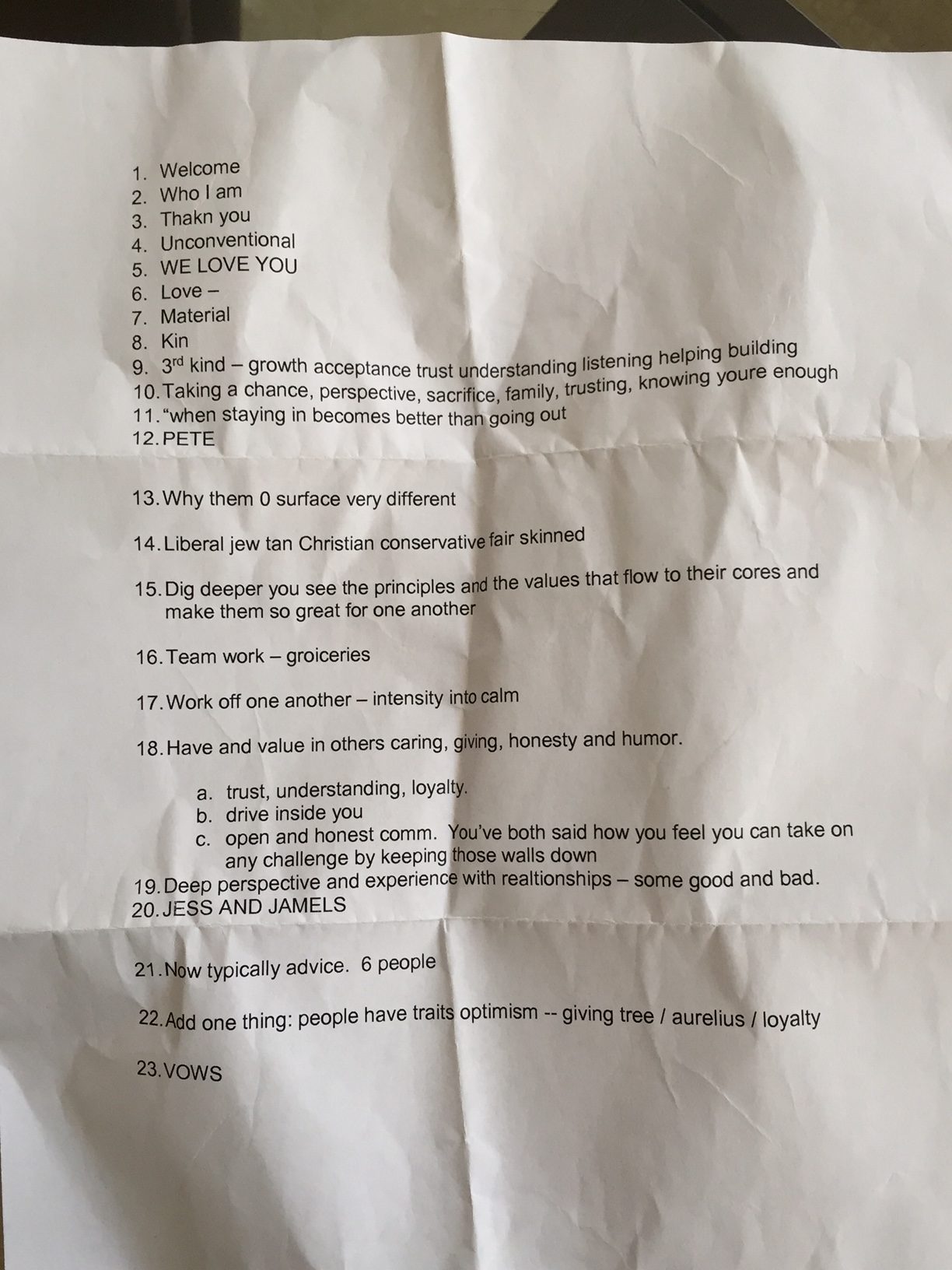
BONUS. Step 8: Care and Write What You Believe
BUT ULTIMATELY, all of the above are merely tactics: mental and organizational tricks that kept my mind away from fear and distraction. But they were not the real drivers of this project.
There were two things above all that were truly responsible for pushing this project (or any, for that matter) to completion: (1) belief and (2) care.This is, my deep care for Marni and Shawn, and the belief in what I was writing.
It is far harder to act like you care or make up some imaginary world in which you do not believe. That is why many artists, comedians, writers, and actors among them, will tell you to write or tell or act the truth.
IF you believe and you care, it will come through and the emotional connection will grab your audience. And it also makes it a hell of a lot easier to write the thing. (Remember what George says: it isn’t a lie if you believe it).
My advice: definitely try steps 1-7, but, ultimately, only say yes to things and people you care about. If you care about them, you will be able to write what you really believe, and that will make any bit of writing compelling. This was made insanely easy for me by how easy my sister and Shawn make it to care about them.
Don’t have a sister? Convince your parents to have another child…
Ok.., that was a lot of steps, let’s quickly summarize:
To Sum Up: “You Look Young, We’re Having Fun…”
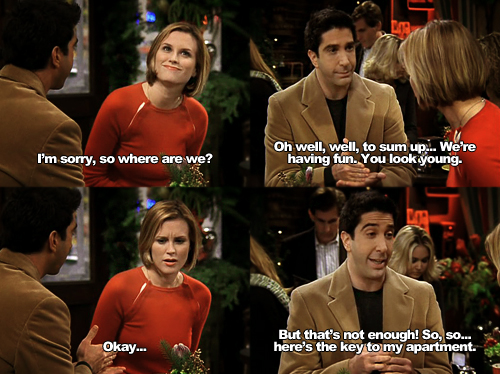
- Decide WHAT. You first need to decide on the clear goal and parameters. What kind of wedding are we trying to achieve?
- ***bonus points if you can tell yourself WHY you are doing this (because I care about my big sister, for instance). This will fuel your writing and your desire to do well.
- Find a Teacher. The best way to learn, or at least get the initial lay out, is through models – whether live or dead. (No, I don’t mean people who used to pose for pictures and have since passed away, sicko). Find a teacher who has done what you want to do and copy them.
- Form a Plan and Schedule It By Priority. After you understand what needs to be done, take a look at the time you have to complete, and plan accordingly. Remember, do the hard and long things first.
- Gathering Sand–Piles: Research. Read, watch videos of others, brainstorm, interview, observe.
- Write A Shitty First Draft. Don’t be perfect or even good. Just write it all out on a page. Do this very early on to benefit from procrastination. Edit it so it is legible. Send it to someone for feedback.
- Logistics and Collaboration. While you wait for feedback (and while your subconscious works on the writing) do the forming of the ceremony: administrative, organizational, and involve others.
- Rewrite and Memorize. Writing is rewriting. Keep refining, shortening, taking out things that don’t matter. Kill your darlings. Distill, repeat, say out-loud based on recall. Embarrass yourself in front of a windowed reflection.
- BONUS: Care and Believe. You must care about what you are writing. This will allow you to write things you believe and make for compelling writing.
***
I Now Pronounce You… (My Big Goof)
“How we spend our days is, of course, how we spend our lives. What we do in this hour, and that one, is what we are doing…There is no shortage of good days. It is good lives that are hard to come by.” Annie Dillard, The Writing Life
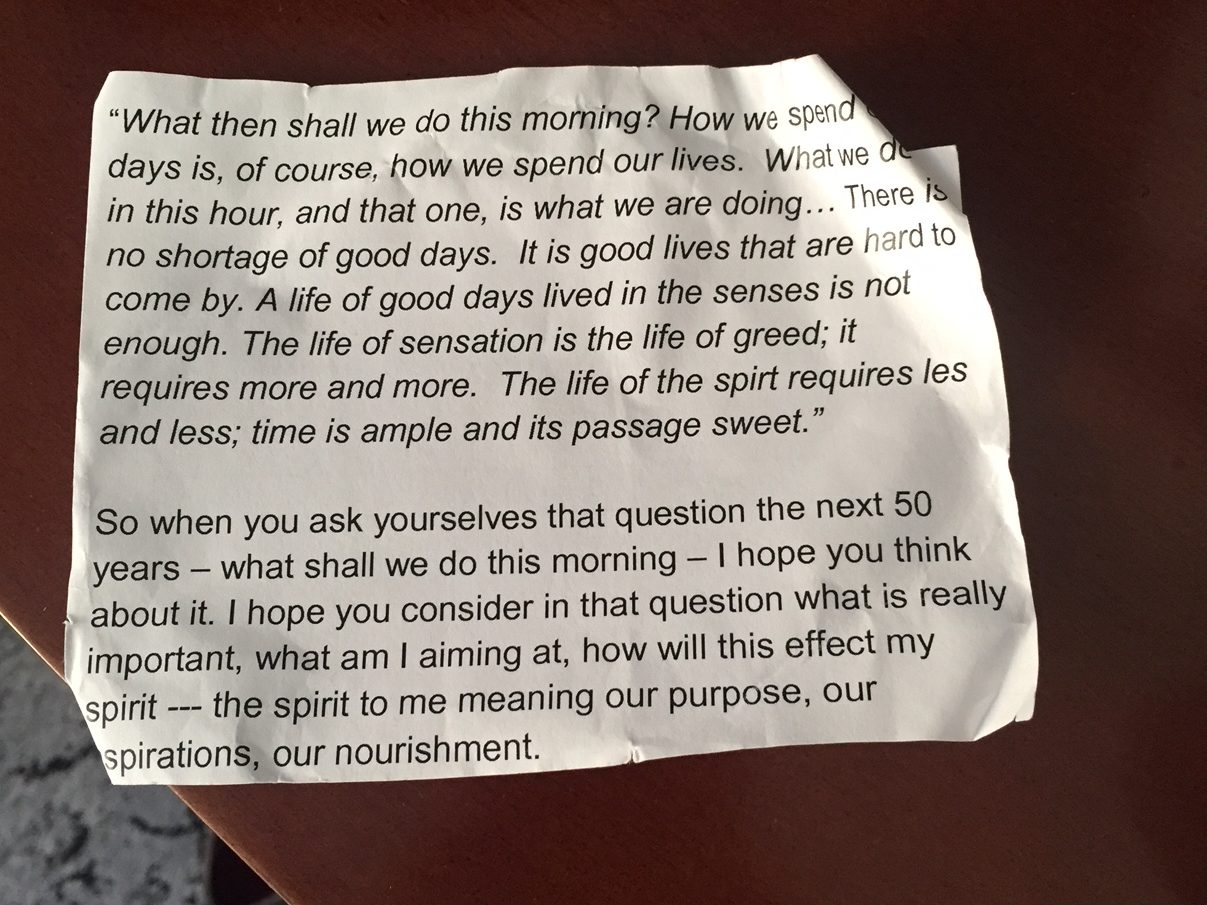
It is with this quote I ended the ceremony, feeling a rush of nearly overwhelming emotion for the newlyweds, and, if I’m being honest, relief for myself. It wasn’t perfect, but it also wasn’t a train wreck. I did good for my big sis.
My mind now slightly in the clouds, I moved to what I figured was the next step – I went to pronounce them (in my high-holiness) man and wife. But, my sister stopped me. “Justin… the rings…” she whispered, trying to conceal her voice, but with no attempt to conceal her what-the-fuck-are-you-doing stare.
The rings!!!!!! (Kevin!!)

“Holy hell” I screamed, “I forgot the rings!”
Everyone laughed, and it tuned out OK, especially because this was a very relaxed and informal wedding. I mean, I was barefoot for god’s sake. But, informal or not, if you’re taking notes, I’d probably leave that part out…
***
And that’s it boys and girls – that’s how to be a “natural” in officiating.
Happy anniversary, Marnz and Shawn.
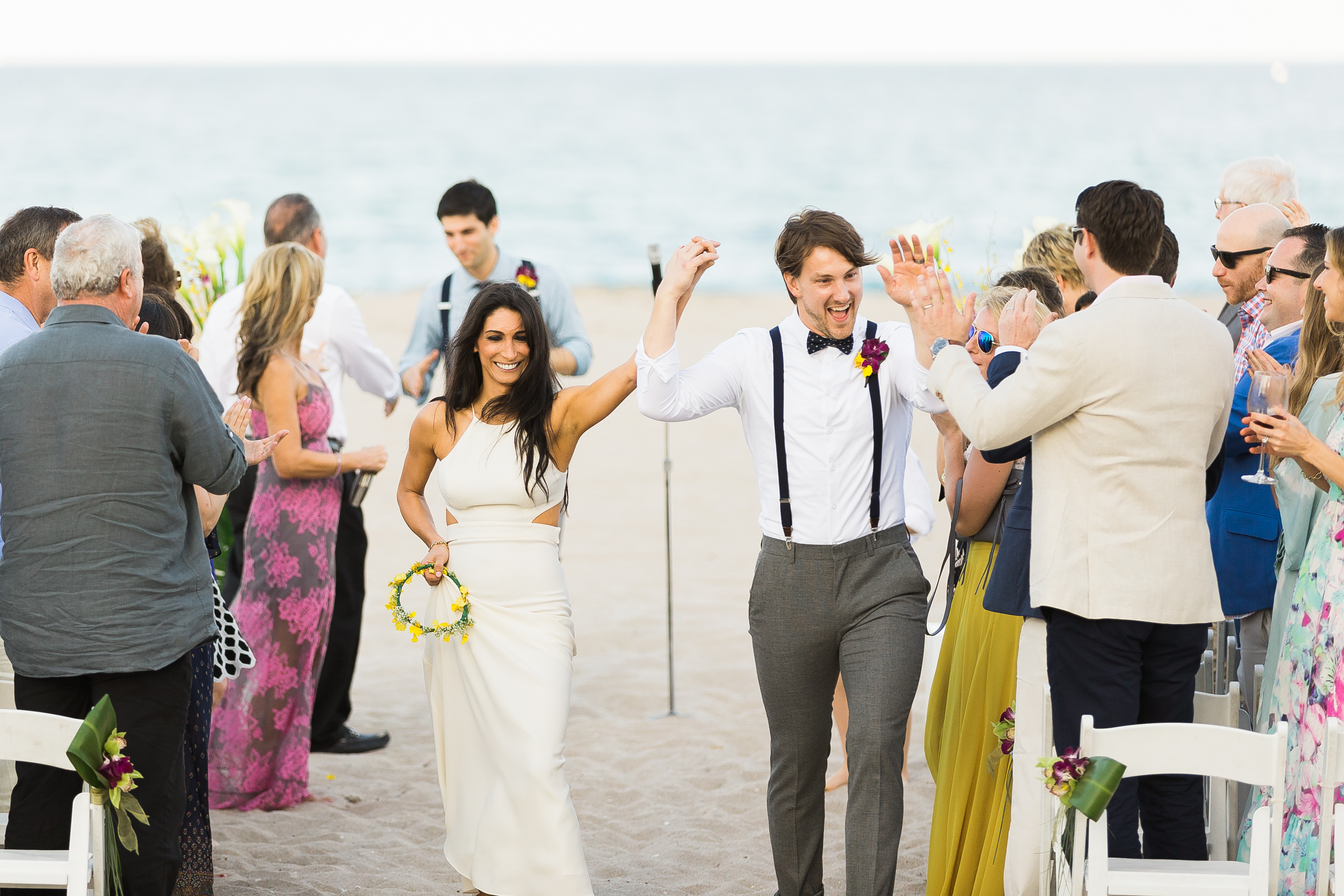
Besos,
Justy
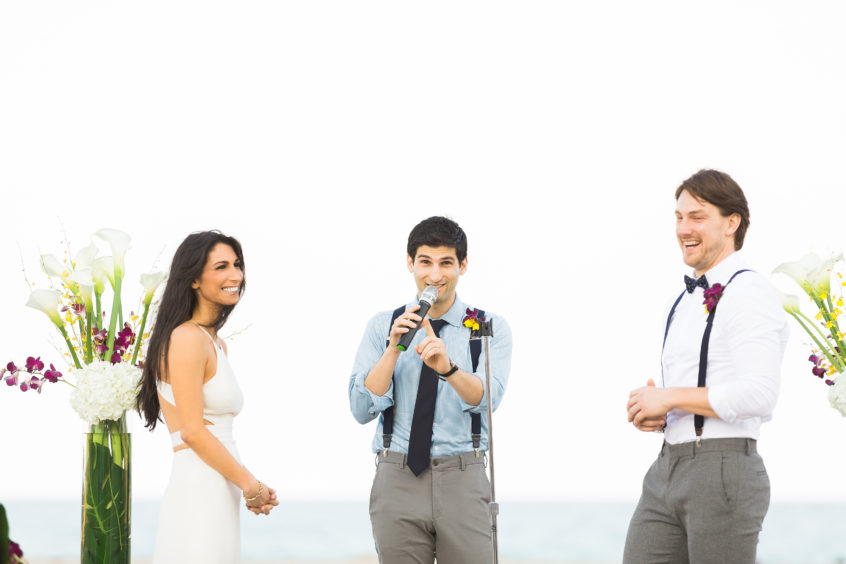




One Comment on “How To Marry Your Sister (I Mean…Officiate Her Wedding)”
Loved it! Made me cry(of course, what else is new?). I thought you were great! I didn’t know you put all that research into it! On the other hand, I know when you make a commitment, you put your heart and soul into it! I’m so proud of my Justy Pusty!
I love you,
The Momzy